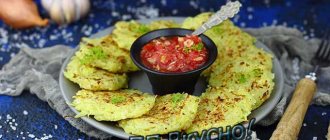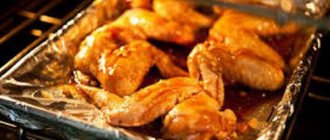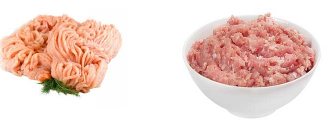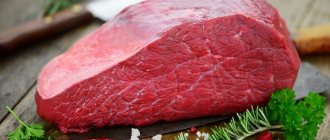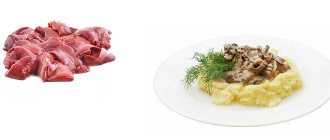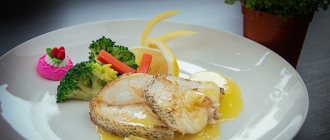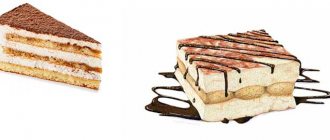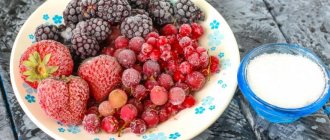Calorie content of boiled chicken necks. Chemical composition and nutritional value.
Nutritional value and chemical composition of “boiled chicken necks”.
The table shows the nutritional content (calories, proteins, fats, carbohydrates, vitamins and minerals) per 100 grams of edible portion.
| Nutrient | Quantity | Norm** | % of the norm in 100 g | % of the norm in 100 kcal | 100% normal |
| Calorie content | 175.33 kcal | 1684 kcal | 10.4% | 5.9% | 960 g |
| Squirrels | 20.85 g | 76 g | 27.4% | 15.6% | 365 g |
| Fats | 10 g | 56 g | 17.9% | 10.2% | 560 g |
The energy value of boiled chicken necks is 175.33 kcal.
Primary Source: Created in the application by the user. Read more.
** This table shows the average levels of vitamins and minerals for an adult. If you want to know the norms taking into account your gender, age and other factors, then use the “My Healthy Diet” application.
How many calories are in chicken and chicken by-products of different cooking methods?
It all depends on:
- what part of the chicken was cooked;
- how it is prepared;
- how she was prepared.
Different parts of chicken have different levels of fat and cholesterol. When counting the calories in a chicken dish, it's important to consider these factors because there will ultimately be a big difference between one chicken leg and one half chicken breast, or between a fried breast and a grilled one.
Chicken can be called a healthy or unhealthy food depending on how it is prepared. Probably the most famous way to cook chicken is chicken soup, which is especially useful for colds. Fried chicken is clearly not healthy, but boiled chicken is not only tasty, but also healthy. Additionally, the freshness of the chicken also influences the health benefits. Frozen chicken is not healthy because it contains preservatives. But fresh chicken is packed with healthy proteins.
If you are concerned about the number of calories you consume in chicken dishes, remove the chicken skin before eating as it contains a lot of fat.
| How many calories are in whole chicken? | ||
| Chicken product/chicken dish | Calorie content, kcal per 100 grams | Calorie content, kcal per 1 piece. |
| Domestic chicken carcass | 195,09 | 2926 |
| Broiler carcass | 219 | 6570 |
| Chicken carcass | 201,07 | 1053,5 |
| How many calories are in different parts of chicken? | ||
| Chicken product/chicken dish | Calorie content, kcal per 100 grams | |
| Shin (leg) | 177,77 | |
| Quarter (ham) | 181,73 | |
| Hip | 181,28 | |
| Carbonate | 190 | |
| Fillet | 124,20 | |
| Breast | 115,77 | |
| Necks | 166,55 | |
| Wings (wings) | 198,51 | |
| Paws | 130 | |
| Backrests | 319 | |
| How many calories are in chicken by-products? | ||
| Chicken product/chicken dish | Calorie content, kcal per 100 grams | |
| Liver | 142,75 | |
| Hearts (hearts) | 160,33 | |
| Navels | 114,76 | |
| Stomachs (ventricles) | 127,35 | |
| Leather | 206,80 | |
| How many calories are in chicken in different cooking methods? | ||
| Chicken product/chicken dish | Calorie content, kcal per 100 grams | |
| Raw | 191,09 | |
| Boiled | 166,83 | |
| Boiled breast without skin | 241 | |
| Fried | 228,75 | |
| Stewed | 169,83 | |
| Smoked | 184 | |
| Grill | 183,78 | |
| Baked in the oven | 244,66 | |
| White meat chicken broth | 15 | |
| Ground meat | 143 | |
Calorie content of chicken necks. Chemical composition and nutritional value.
Nutritional value and chemical composition of “chicken necks”.
The table shows the nutritional content (calories, proteins, fats, carbohydrates, vitamins and minerals) per 100 grams of edible portion.
| Nutrient | Quantity | Norm** | % of the norm in 100 g | % of the norm in 100 kcal | 100% normal |
| Calorie content | 297 kcal | 1684 kcal | 17.6% | 5.9% | 567 g |
| Squirrels | 14.07 | 76 g | 18.5% | 6.2% | 540 g |
| Fats | 26.24 g | 56 g | 46.9% | 15.8% | 213 g |
The energy value of chicken necks is 297 kcal.
Primary Source: Created in the application by the user. Read more.
** This table shows the average levels of vitamins and minerals for an adult. If you want to know the norms taking into account your gender, age and other factors, then use the “My Healthy Diet” application.
Mineral composition
The ratio of mineral substances (macro- and microelements) contained in chicken thighs is presented in the table using diagrams.
| Minerals, content | Share of daily value per 100 g | |
| Calcium | 7.0 mg | 0,7% |
| Iron | 0.7 mg | 6,8% |
| Magnesium | 18.0 mg | 4,5% |
| Phosphorus | 157.0 mg | 22,4% |
| Potassium | 204.0 mg | 4,3% |
| Sodium | 81.0 mg | 6,2% |
| Zinc | 1.3 mg | 11,7% |
| Copper | 0.1 mg | 6,0% |
| Manganese | 0.0 mg | 0,6% |
| Selenium | 18.9 mcg | 34,4% |
| Fluorine | n/a | 0,0% |
Calorie content of Chicken necks. Chemical composition and nutritional value.
Nutritional value and chemical composition of “Chicken necks”.
The table shows the nutritional content (calories, proteins, fats, carbohydrates, vitamins and minerals) per 100 grams of edible portion.
| Nutrient | Quantity | Norm** | % of the norm in 100 g | % of the norm in 100 kcal | 100% normal |
| Calorie content | 182 kcal | 1684 kcal | 10.8% | 5.9% | 925 g |
| Squirrels | 18.7 g | 76 g | 24.6% | 13.5% | 406 g |
| Fats | 11.4 g | 56 g | 20.4% | 11.2% | 491 g |
| Carbohydrates | 0.2 g | 219 g | 0.1% | 0.1% | 109500 g |
The energy value of Chicken necks is 182 kcal.
Primary Source: Created in the application by the user. Read more.
** This table shows the average levels of vitamins and minerals for an adult. If you want to know the norms taking into account your gender, age and other factors, then use the “My Healthy Diet” application.
Chicken necks calorie content
vpechenke.ru RP RESULTS I'm sorry I'm sorry! Sorry. Печенье Ñ Ð¿Ñ€ÐµÐ´Ñ ÐºÐ°Ð·Ð°Ð½Ð¸Ñ Ð¼Ð¸ — Ñ Ñ‚Ð¾.
Alexa Rank: #3,782,353 Google PageRank: 0 out of 10
RESULTS µÐ¹Ð½Ñ‹Ñ пар, Ð¿Ñ Ð¸Ñ Ð¾Ð »Ð¾Ð³Ð¸Ñ‡ÐµÑ кий клуб Ð´Ð»Ñ Ð¶ÐµÐ½Ñ‰Ð¸Ð½, Ð¿Ñ Ð¸Ñ Ð¾Ð»Ð¾Ð³Ð¸ Ñ‡ÐµÑ ÐºÐ¸Ðµ тренинги › †Ð²ÐµÑ‚Ð°Ð½Ð¸Ñ .
Google PageRank: 2 out of 10
Google PageRank: 0 out of 10
RESULTS ´ÑƒÐºÑ‚Ñ‹, домик в дер евне, Ñ ÐºÐ¾ продукты
Google PageRank: 0 out of 10
image00 1 round ° ROOM ‰Ð¸Ð½Ñ‹ быть Ð²Ñ › › ›
Google PageRank: 0 out of 10
RESULTS. RESULTS , , , , , , RESULTS одный âˆ'ÐºÑƒÐ¿Ð»Ñ Ð ¶ÐµÐ½Ñ ÐºÐ°Ñ Ð¾Ð´ÐµÐ¶Ð´Ð°.
Calories in chicken neck. Chemical composition and nutritional value.
Nutritional value and chemical composition of “chicken neck”.
The table shows the nutritional content (calories, proteins, fats, carbohydrates, vitamins and minerals) per 100 grams of edible portion.
| Nutrient | Quantity | Norm** | % of the norm in 100 g | % of the norm in 100 kcal | 100% normal |
| Calorie content | 181 kcal | 1684 kcal | 10.7% | 5.9% | 930 g |
| Squirrels | 16.5 g | 76 g | 21.7% | 12% | 461 g |
| Fats | 12.6 g | 56 g | 22.5% | 12.4% | 444 g |
The energy value of chicken neck is 181 kcal.
Primary Source: Created in the application by the user. Read more.
** This table shows the average levels of vitamins and minerals for an adult. If you want to know the norms taking into account your gender, age and other factors, then use the “My Healthy Diet” application.
Calorie content of chicken necks. Chemical composition and nutritional value.
chicken necks
are rich in vitamins and minerals such as: choline - 15.2%, vitamin B5 - 15.2%, vitamin B6 - 26%, vitamin B12 - 18.3%, vitamin H - 20%, vitamin PP - 62, 5%, phosphorus - 20.6%, cobalt - 120%, chromium - 18%, zinc - 17.2%
- Choline
is part of lecithin, plays a role in the synthesis and metabolism of phospholipids in the liver, is a source of free methyl groups, and acts as a lipotropic factor. - Vitamin B5
is involved in protein, fat, carbohydrate metabolism, cholesterol metabolism, the synthesis of a number of hormones, hemoglobin, promotes the absorption of amino acids and sugars in the intestines, and supports the function of the adrenal cortex. A lack of pantothenic acid can lead to damage to the skin and mucous membranes. - Vitamin B6
is involved in maintaining the immune response, processes of inhibition and excitation in the central nervous system, in the transformation of amino acids, the metabolism of tryptophan, lipids and nucleic acids, promotes the normal formation of red blood cells, and maintaining normal levels of homocysteine in the blood. Insufficient intake of vitamin B6 is accompanied by decreased appetite, impaired skin condition, and the development of homocysteinemia and anemia. - Vitamin B12
plays an important role in the metabolism and transformation of amino acids. Folate and vitamin B12 are interconnected vitamins that are involved in hematopoiesis. A lack of vitamin B12 leads to the development of partial or secondary folate deficiency, as well as anemia, leukopenia, and thrombocytopenia. - Vitamin H
is involved in the synthesis of fats, glycogen, and amino acid metabolism. Insufficient consumption of this vitamin can lead to disruption of the normal condition of the skin. - Vitamin PP
is involved in redox reactions of energy metabolism. Insufficient vitamin intake is accompanied by disruption of the normal condition of the skin, gastrointestinal tract and nervous system. - Phosphorus
takes part in many physiological processes, including energy metabolism, regulates acid-base balance, is part of phospholipids, nucleotides and nucleic acids, and is necessary for the mineralization of bones and teeth. Deficiency leads to anorexia, anemia, and rickets. - Cobalt
is part of vitamin B12. Activates enzymes of fatty acid metabolism and folic acid metabolism. - Chromium
is involved in the regulation of blood glucose levels, enhancing the effect of insulin. Deficiency leads to decreased glucose tolerance. - Zinc
is part of more than 300 enzymes and is involved in the processes of synthesis and breakdown of carbohydrates, proteins, fats, nucleic acids and in the regulation of the expression of a number of genes. Insufficient consumption leads to anemia, secondary immunodeficiency, liver cirrhosis, sexual dysfunction, and the presence of fetal malformations. Research in recent years has revealed the ability of high doses of zinc to disrupt the absorption of copper and thereby contribute to the development of anemia.
morehide
You can view a complete directory of the healthiest foods in the “My Healthy Diet” app.
Calorie content Boiled chicken necks. Chemical composition and nutritional value.
Nutritional value and chemical composition of “Boiled chicken necks”.
The table shows the nutritional content (calories, proteins, fats, carbohydrates, vitamins and minerals) per 100 grams of edible portion.
| Nutrient | Quantity | Norm** | % of the norm in 100 g | % of the norm in 100 kcal | 100% normal |
| Calorie content | 236.17 kcal | 1684 kcal | 14% | 5.9% | 713 g |
| Squirrels | 17.46 g | 76 g | 23% | 9.7% | 435 g |
| Fats | 18.12 g | 56 g | 32.4% | 13.7% | 309 g |
The energy value of boiled chicken necks is 236.17 kcal.
Primary Source: Created in the application by the user. Read more.
** This table shows the average levels of vitamins and minerals for an adult. If you want to know the norms taking into account your gender, age and other factors, then use the “My Healthy Diet” application.
Calorie content Boiled chicken necks without skin. Chemical composition and nutritional value.
Nutritional value and chemical composition of “Boiled chicken necks without skin.”
The table shows the nutritional content (calories, proteins, fats, carbohydrates, vitamins and minerals) per 100 grams of edible portion.
| Nutrient | Quantity | Norm** | % of the norm in 100 g | % of the norm in 100 kcal | 100% normal |
| Calorie content | 218.117 kcal | 1684 kcal | 13% | 6% | 772 g |
| Squirrels | 10 g | 76 g | 13.2% | 6.1% | 760 g |
| Fats | 12 g | 56 g | 21.4% | 9.8% | 467 g |
The energy value of boiled skinless chicken necks is 218.117 kcal.
Primary Source: Created in the application by the user. Read more.
** This table shows the average levels of vitamins and minerals for an adult. If you want to know the norms taking into account your gender, age and other factors, then use the “My Healthy Diet” application.
Chicken skin adds calories
While a skinless chicken breast contains 284 calories with 80% protein and 20% fat, these numbers change dramatically when skin is included (1).
One cooked boneless, skin-on chicken breast (196 grams) contains (9):
- Calories: 386 kcal.
- Protein: 58.4 g.
- Fat: 15.2 g.
In skin-on chicken breast, 50% of the calories come from protein and 50% from fat. Plus, eating skin adds almost 100 calories (9).
Likewise, one skin-on chicken wing (34 grams) contains 99 calories, compared to 42 calories for a skinless wing (21 grams). Thus, 60% of the calories in chicken wings with skin come from fat, compared to 36% in skinless wings (3, 10).
So if you're watching your weight or fat intake, eat skinless chicken to minimize calories and fat.
Eating chicken with the skin adds a significant amount of calories and fat. Remove skin before consumption to reduce calories.
Calorie content of chicken necks. Chemical composition and nutritional value.
Nutritional value and chemical composition of “chicken necks”.
The table shows the nutritional content (calories, proteins, fats, carbohydrates, vitamins and minerals) per 100 grams of edible portion.
| Nutrient | Quantity | Norm** | % of the norm in 100 g | % of the norm in 100 kcal | 100% normal |
| Calorie content | 124 kcal | 1684 kcal | 7.4% | 6% | 1358 g |
| Squirrels | 5 g | 76 g | 6.6% | 5.3% | 1520 g |
| Fats | 10 g | 56 g | 17.9% | 14.4% | 560 g |
The energy value of chicken necks is 124 kcal.
Primary Source: Created in the application by the user. Read more.
** This table shows the average levels of vitamins and minerals for an adult. If you want to know the norms taking into account your gender, age and other factors, then use the “My Healthy Diet” application.
Chicken necks according to Dukan - very tasty!
The municipal animal shelter of the South-Western Administrative District of Moscow will gratefully accept donations of leashes, collars, harnesses for medium and large dogs. To display the page correctly, enable JavaScript support in your browser. Only the freshest and most natural food. Happy hour: When ordering from 9. Tripe To the catalogue. Order more goods for RUB. Poultry You can give your pet poultry, game, and rabbit meat. You should not feed your dog raw hunting trophies, and only bird neck bones are considered safe. Skinless chicken is a good food for sensitive stomachs. Chicken meat for dogs and cats must be heat treated: boiled, baked, fried, and carefully separated from the bones, since tubular bones are very dangerous.
Calorie content of Chicken necks. Chemical composition and nutritional value.
Nutritional value and chemical composition of “Chicken necks”.
The table shows the nutritional content (calories, proteins, fats, carbohydrates, vitamins and minerals) per 100 grams of edible portion.
| Nutrient | Quantity | Norm** | % of the norm in 100 g | % of the norm in 100 kcal | 100% normal |
| Calorie content | 297 kcal | 1684 kcal | 17.6% | 5.9% | 567 g |
| Squirrels | 14.07 | 76 g | 18.5% | 6.2% | 540 g |
| Fats | 26.24 g | 56 g | 46.9% | 15.8% | 213 g |
The energy value of Chicken necks is 297 kcal.
Primary Source: Created in the application by the user. Read more.
** This table shows the average levels of vitamins and minerals for an adult. If you want to know the norms taking into account your gender, age and other factors, then use the “My Healthy Diet” application.
Calorie content
KBZHU is an important indicator for specialists in rational and healthy nutrition, as well as for people who monitor their weight and health.
100 grams of boiled paws contain no more than 215 kilocalories. Proteins, fats and carbohydrates are in the following proportions: 19 grams - 14 grams - 0.2 grams. The amount of cholesterol can reach 80 mg, the product also contains saturated fatty acids in the amount of 3.5 grams and water 65 grams.
Chicken by-product does not contain dietary fiber.
When creating menus for various diets, it is necessary to take into account that the number of calories in a fried or pickled product is much higher than in a stewed or boiled product.
Chicken necks recipe. Calorie, chemical composition and nutritional value.
| Nutrient | Quantity | Norm** | % of the norm in 100 g | % of the norm in 100 kcal | 100% normal |
| Calorie content | 139.4 kcal | 1684 kcal | 8.3% | 6% | 1208 g |
| Squirrels | 11.3 g | 76 g | 14.9% | 10.7% | 673 g |
| Fats | 8.9 g | 56 g | 15.9% | 11.4% | 629 g |
| Carbohydrates | 2.6 g | 219 g | 1.2% | 0.9% | 8423 g |
| Organic acids | 0.1 g | ~ | |||
| Alimentary fiber | 0.8 g | 20 g | 4% | 2.9% | 2500 g |
| Water | 189 g | 2273 g | 8.3% | 6% | 1203 g |
| Ash | 0.773 g | ~ | |||
| Vitamins | |||||
| Vitamin A, RE | 180 mcg | 900 mcg | 20% | 14.3% | 500 g |
| Retinol | 0.027 mg | ~ | |||
| beta carotene | 0.917 mg | 5 mg | 18.3% | 13.1% | 545 g |
| Vitamin B1, thiamine | 0.05 mg | 1.5 mg | 3.3% | 2.4% | 3000 g |
| Vitamin B2, riboflavin | 0.151 mg | 1.8 mg | 8.4% | 6% | 1192 g |
| Vitamin B5, pantothenic | 0.712 mg | 5 mg | 14.2% | 10.2% | 702 g |
| Vitamin B6, pyridoxine | 0.214 mg | 2 mg | 10.7% | 7.7% | 935 g |
| Vitamin B9, folates | 7.508 mcg | 400 mcg | 1.9% | 1.4% | 5328 g |
| Vitamin B12, cobalamin | 0.197 mcg | 3 mcg | 6.6% | 4.7% | 1523 g |
| Vitamin C, ascorbic acid | 2.8 mg | 90 mg | 3.1% | 2.2% | 3214 g |
| Vitamin E, alpha tocopherol, TE | 1.617 mg | 15 mg | 10.8% | 7.7% | 928 g |
| Vitamin H, biotin | 0.236 mcg | 50 mcg | 0.5% | 0.4% | 21186 g |
| Vitamin K, phylloquinone | 1 mcg | 120 mcg | 0.8% | 0.6% | 12000 g |
| Vitamin RR, NE | 2.7613 mg | 20 mg | 13.8% | 9.9% | 724 g |
| Niacin | 0.132 mg | ~ | |||
| Macronutrients | |||||
| Potassium, K | 181.46 mg | 2500 mg | 7.3% | 5.2% | 1378 g |
| Calcium, Ca | 26.7 mg | 1000 mg | 2.7% | 1.9% | 3745 g |
| Magnesium, Mg | 17.93 mg | 400 mg | 4.5% | 3.2% | 2231 g |
| Sodium, Na | 52.77 mg | 1300 mg | 4.1% | 2.9% | 2464 g |
| Sera, S | 14.05 mg | 1000 mg | 1.4% | 1% | 7117 g |
| Phosphorus, Ph | 88.4 mg | 800 mg | 11.1% | 8% | 905 g |
| Chlorine, Cl | 5.59 mg | 2300 mg | 0.2% | 0.1% | 41145 g |
| Microelements | |||||
| Aluminium, Al | 109 mcg | ~ | |||
| Bor, B | 42.7 mcg | ~ | |||
| Iron, Fe | 1.557 mg | 18 mg | 8.7% | 6.2% | 1156 g |
| Yod, I | 0.64 mcg | 150 mcg | 0.4% | 0.3% | 23438 g |
| Cobalt, Co | 1.067 mcg | 10 mcg | 10.7% | 7.7% | 937 g |
| Lithium, Li | 0.44 mcg | ~ | |||
| Manganese, Mn | 0.0709 mg | 2 mg | 3.5% | 2.5% | 2821 g |
| Copper, Cu | 86.45 mcg | 1000 mcg | 8.6% | 6.2% | 1157 g |
| Nickel, Ni | 0.64 mcg | ~ | |||
| Rubidium, Rb | 101.5 mcg | ~ | |||
| Selenium, Se | 8.323 mcg | 55 mcg | 15.1% | 10.8% | 661 g |
| Fluorine, F | 24.88 mcg | 4000 mcg | 0.6% | 0.4% | 16077 g |
| Chromium, Cr | 0.43 mcg | 50 mcg | 0.9% | 0.6% | 11628 g |
| Zinc, Zn | 1.8322 mg | 12 mg | 15.3% | 11% | 655 g |
| Digestible carbohydrates | |||||
| Starch and dextrins | 0.055 g | ~ | |||
| Mono- and disaccharides (sugars) | 2.6 g | max 100 g | |||
| Glucose (dextrose) | 0.461 g | ~ | |||
| Sucrose | 1.643 g | ~ | |||
| Fructose | 0.329 g | ~ | |||
| Essential amino acids | 0.084 g | ~ | |||
| Arginine* | 0.689 g | ~ | |||
| Valin | 0.544 g | ~ | |||
| Histidine* | 0.34 g | ~ | |||
| Isoleucine | 0.582 g | ~ | |||
| Leucine | 0.825 g | ~ | |||
| Lysine | 0.934 g | ~ | |||
| Methionine | 0.302 g | ~ | |||
| Methionine + Cysteine | 0.006 g | ~ | |||
| Threonine | 0.467 g | ~ | |||
| Tryptophan | 0.131 g | ~ | |||
| Phenylalanine | 0.44 g | ~ | |||
| Phenylalanine+Tyrosine | 0.019 g | ~ | |||
| Nonessential amino acids | 0.185 g | ~ | |||
| Alanin | 0.605 g | ~ | |||
| Aspartic acid | 0.988 g | ~ | |||
| Glycine | 0.542 g | ~ | |||
| Glutamic acid | 1.682 g | ~ | |||
| Proline | 0.453 g | ~ | |||
| Serin | 0.38 g | ~ | |||
| Tyrosine | 0.372 g | ~ | |||
| Cysteine | 0.142 g | ~ | |||
| Sterols (sterols) | |||||
| Cholesterol | 51.13 mg | max 300 mg | |||
| beta sitosterol | 6.933 mg | ~ | |||
| Saturated fatty acids | |||||
| Saturated fatty acids | 1.8 g | max 18.7 g | |||
| 12:0 Lauric | 0.025 g | ~ | |||
| 14:0 Miristinovaya | 0.031 g | ~ | |||
| 16:0 Palmitinaya | 1.139 g | ~ | |||
| 18:0 Stearic | 0.506 g | ~ | |||
| 20:0 Arakhinovaya | 0.01 g | ~ | |||
| 22:0 Begenovaya | 0.024 g | ~ | |||
| Monounsaturated fatty acids | 2.507 g | min 16.8 g | 14.9% | 10.7% | |
| 16:1 Palmitoleic | 0.246 g | ~ | |||
| 18:1 Oleic (omega-9) | 2.22 g | ~ | |||
| 20:1 Gadoleic (omega-9) | 0.012 g | ~ | |||
| Polyunsaturated fatty acids | 3.416 g | from 11.2 to 20.6 g | 30.5% | 21.9% | |
| 18:2 Linolevaya | 3.102 g | ~ | |||
| 18:3 Linolenic | 0.043 g | ~ | |||
| 20:4 Arachidonic | 0.129 g | ~ | |||
| 20:5 Eicosapentaenoic acid (EPA), Omega-3 | 0.012 g | ~ | |||
| Omega-3 fatty acids | 0.1 g | from 0.9 to 3.7 g | 11.1% | 8% | |
| 22:5 Docosapentaenoic acid (DPA), Omega-3 | 0.025 g | ~ | |||
| 22:6 Docosahexaenoic acid (DHA), Omega-3 | 0.049 g | ~ | |||
| Omega-6 fatty acids | 1.2 g | from 4.7 to 16.8 g | 25.5% | 18.3% |
Micro- and macroelements in Chicken necks
Chicken necks contain the following elements: SFA - Saturated fatty acids, Cholesterol, Ash, Water, Sodium, Potassium, Phosphorus, Magnesium, Calcium, Copper, Manganese, Selenium, Zinc, Iron.
| Micro and macro element | Meaning |
| SFA - Saturated fatty acids, g. | 7,27 |
| Cholesterol, mg | 99 |
| Zola, Mr. | 0,55 |
| Water, city | 59,99 |
| Sodium, mg | 64 |
| Potassium, mg | 137 |
| Phosphorus, mg | 112 |
| Magnesium, mg | 13 |
| Calcium, mg | 18 |
| Copper, µg | 80 |
| Manganese, mg | 0,033 |
| Selenium, mcg | 12 |
| Zinc, mg | 1,86 |
| Iron, mg | 1,9 |
Calorie content of Chicken necks. Chemical composition and nutritional value.
Nutritional value and chemical composition of “Chicken necks”.
The table shows the nutritional content (calories, proteins, fats, carbohydrates, vitamins and minerals) per 100 grams of edible portion.
| Nutrient | Quantity | Norm** | % of the norm in 100 g | % of the norm in 100 kcal | 100% normal |
| Calorie content | 298 kcal | 1684 kcal | 17.7% | 5.9% | 565 g |
| Squirrels | 16.7 g | 76 g | 22% | 7.4% | 455 g |
| Fats | 26.24 g | 56 g | 46.9% | 15.7% | 213 g |
The energy value of Chicken necks is 298 kcal.
Primary Source: Created in the application by the user. Read more.
** This table shows the average levels of vitamins and minerals for an adult. If you want to know the norms taking into account your gender, age and other factors, then use the “My Healthy Diet” application.
